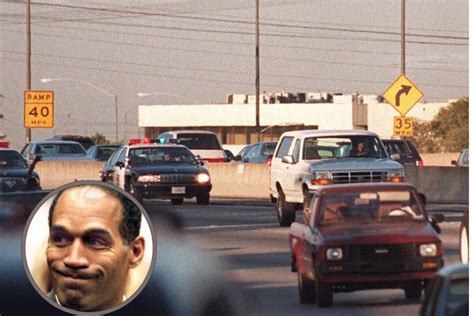
On the 30th anniversary of one of the most bizarre and captivating events in sports and legal history, photographs from O.J. Simpson’s slow-speed chase in a white Ford Bronco on June 17, 1994, have resurfaced, reminding the public of the day “The Juice got loose.” The infamous pursuit, broadcast live across the nation, unfolded after Simpson was charged with the murders of his ex-wife, Nicole Brown Simpson, and her friend, Ronald Goldman.
The chase commenced when Simpson, accompanied by his friend Al Cowlings (A.C.), failed to turn himself in to authorities as arranged. Instead, Cowlings drove Simpson in his white Bronco, leading law enforcement on a slow-speed pursuit across Los Angeles freeways. An estimated 95 million people tuned in to watch the surreal event unfold on television, eclipsing even the NBA Finals game that was underway. The images from that day – the Bronco inching along the highway, police cruisers in tow, and crowds of onlookers gathering on overpasses – remain etched in the collective memory of a generation.
The day began with heightened anticipation as Simpson was expected to surrender to police. Detectives had been investigating the brutal murders of Nicole Brown Simpson and Ronald Goldman, which occurred on June 12, 1994, outside Nicole’s Brentwood condominium. Simpson quickly became the prime suspect, and the evidence against him appeared increasingly damning.
When Simpson failed to appear at the designated time, authorities realized he had gone missing. It was later revealed that he had written a letter that was interpreted by some as a suicide note. This prompted a widespread search, culminating in the discovery of Simpson in the back of Cowlings’ white Ford Bronco.
Cowlings, at the wheel, informed authorities that Simpson was armed and distraught. This led to the now-infamous slow-speed chase, with Cowlings reportedly telling police that Simpson had a gun to his head and was threatening to harm himself. The pursuit began in Orange County and wound its way through the Los Angeles area, drawing crowds of bewildered and captivated onlookers.
News helicopters hovered above, providing live aerial footage that was broadcast on every major television network. People lined the overpasses, holding signs of support for Simpson, while others simply stood in stunned silence, trying to comprehend the unfolding drama. The visual spectacle was surreal, transforming a murder investigation into a bizarre form of public theater.
The chase eventually ended at Simpson’s Rockingham estate in Brentwood. After lengthy negotiations with police, Simpson surrendered and was taken into custody. The images of Simpson emerging from the Bronco, hands raised, became another iconic snapshot from that day.
The events of June 17, 1994, were not just a footnote in the O.J. Simpson saga; they became a defining moment that encapsulated the complexities of celebrity, race, and justice in America. The Bronco chase transformed a murder investigation into a national spectacle, blurring the lines between news and entertainment.
The trial that followed was equally sensational. Dubbed the “Trial of the Century,” it captivated the nation for months. The prosecution presented a mountain of forensic evidence, while the defense argued that Simpson was framed by racist police officers. The trial exposed deep racial divisions in American society and raised questions about the fairness of the justice system.
On October 3, 1995, after a lengthy and highly publicized trial, Simpson was acquitted of the murders of Nicole Brown Simpson and Ronald Goldman. The verdict was met with shock and disbelief by many, while others celebrated what they saw as a victory against a biased system.
Despite the acquittal, the civil case that followed found Simpson liable for the wrongful deaths of Brown and Goldman. He was ordered to pay $33.5 million in damages, a sum that he struggled to fulfill throughout his life.
The legacy of the O.J. Simpson case continues to resonate today. It remains a touchstone in discussions about race, celebrity, and the justice system. The Bronco chase, the trial, and the aftermath have been the subject of numerous books, documentaries, and television shows, each attempting to unravel the complexities of this enduring American tragedy. The photos that have resurfaced serve as a stark reminder of that unforgettable day when America watched, transfixed, as “The Juice got loose.”
The details surrounding the chase and Simpson’s state of mind remain a subject of debate. While Cowlings claimed Simpson was suicidal, others have suggested that he was simply trying to evade capture. Regardless of his motivations, the Bronco chase remains one of the most bizarre and captivating events in modern history.
The sheer scale of media coverage devoted to the O.J. Simpson case was unprecedented. The 24-hour news cycle was still in its infancy, but the Simpson case helped to usher in a new era of sensationalized news coverage. The trial became a cultural phenomenon, with people from all walks of life debating the evidence and offering their opinions on Simpson’s guilt or innocence.
The impact of the O.J. Simpson case on the American legal system is also significant. The trial raised questions about the admissibility of evidence, the role of expert witnesses, and the influence of media coverage on jury deliberations. The case also led to reforms in the way DNA evidence is collected and analyzed.
The O.J. Simpson case also had a profound impact on the lives of the families of Nicole Brown Simpson and Ronald Goldman. They were forced to endure the pain of reliving the details of the murders on a daily basis. The trial and its aftermath brought them little closure, and they have continued to fight for justice for their loved ones.
The story of O.J. Simpson is a cautionary tale about the dangers of fame, fortune, and unchecked privilege. Simpson was once a beloved sports icon, but his life was ultimately destroyed by his own actions. The Bronco chase serves as a symbol of his fall from grace, a moment when his carefully constructed image shattered before the eyes of the world.
Even decades later, the details of the chase remain vivid in the memories of those who witnessed it. The images of the white Bronco, the police cars, and the crowds of onlookers are forever etched in the collective consciousness. The O.J. Simpson case continues to fascinate and disturb, a reminder of the dark side of the American Dream.
The case also highlighted the role of race in American society. Simpson’s defense team successfully argued that he was being targeted because he was black. This resonated with many African Americans who felt that the justice system was biased against them. The Simpson trial exposed deep racial divisions in American society and sparked a national conversation about race and justice.
The Bronco chase also raised questions about the role of the media in shaping public opinion. The media coverage of the Simpson case was often sensationalized and biased. This led to accusations that the media was trying to influence the jury. The Simpson case highlighted the power of the media to shape public perceptions and the importance of responsible journalism.
The O.J. Simpson case is a complex and multifaceted story that continues to fascinate and disturb. The Bronco chase is just one chapter in this saga, but it is a chapter that is forever etched in the collective memory of America. The resurfaced photos serve as a reminder of this unforgettable day and the many questions that remain unanswered.
The long shadow of the O.J. Simpson case also extends to the realm of sports. The case tarnished the image of professional athletes and raised questions about their behavior both on and off the field. The Simpson case served as a wake-up call for sports leagues and teams, prompting them to adopt stricter codes of conduct for their players.
The legal battles surrounding the O.J. Simpson case continued for years after the criminal trial. The civil trial resulted in a judgment against Simpson, but he struggled to pay the damages. The Goldman family pursued Simpson’s assets for years, seeking to collect the money they were owed. The legal saga surrounding the O.J. Simpson case is a testament to the enduring pain and suffering of the victims’ families.
The O.J. Simpson case also had a significant impact on the legal profession. The trial exposed weaknesses in the criminal justice system and led to reforms in the way cases are prosecuted and defended. The Simpson case also raised ethical questions for lawyers, particularly those who represent high-profile clients.
The legacy of the O.J. Simpson case is complex and multifaceted. It is a story of fame, fortune, race, justice, and tragedy. The Bronco chase is just one chapter in this saga, but it is a chapter that is forever etched in the collective memory of America. The resurfaced photos serve as a reminder of this unforgettable day and the many questions that remain unanswered.
The O.J. Simpson case also highlighted the issue of domestic violence. Nicole Brown Simpson had repeatedly accused Simpson of abuse during their marriage. The prosecution argued that the murders were the culmination of a pattern of domestic violence. The Simpson case brought the issue of domestic violence to the forefront of public consciousness and led to increased awareness and resources for victims of abuse.
The Bronco chase also served as a reminder of the power of live television. The chase was broadcast live on every major network, captivating millions of viewers. The event demonstrated the ability of television to bring major news events directly into people’s homes. The Simpson case helped to usher in a new era of 24-hour news coverage and the rise of cable news networks.
The O.J. Simpson case also had a significant impact on popular culture. The case has been the subject of numerous books, movies, and television shows. The Simpson case has become a cultural touchstone, a shorthand for discussing issues of race, class, and justice in America.
The O.J. Simpson case is a story that continues to resonate with people of all ages and backgrounds. The Bronco chase is just one chapter in this saga, but it is a chapter that is forever etched in the collective memory of America. The resurfaced photos serve as a reminder of this unforgettable day and the many questions that remain unanswered.
The enduring fascination with the O.J. Simpson case speaks to the complexities of American society. The case touches on issues of race, class, celebrity, and justice. The Bronco chase is a symbol of the case’s many contradictions and ambiguities. The resurfaced photos serve as a reminder of the enduring power of this story to provoke debate and reflection.
The O.J. Simpson case is a reminder that even the most famous and successful people are not immune to tragedy and scandal. The Bronco chase is a symbol of Simpson’s fall from grace, a moment when his carefully constructed image shattered before the eyes of the world. The resurfaced photos serve as a reminder of the fragility of fame and the enduring consequences of one’s actions.
The impact of the O.J. Simpson case on the American psyche is undeniable. The case exposed deep divisions in American society and raised questions about the fairness of the justice system. The Bronco chase is a symbol of the case’s many complexities and contradictions. The resurfaced photos serve as a reminder of the enduring power of this story to provoke debate and reflection.
In conclusion, the resurfacing of the photographs from O.J. Simpson’s Bronco chase serves as a stark reminder of a pivotal moment in American history. The events of June 17, 1994, continue to resonate, sparking conversations about race, justice, celebrity, and the media’s role in shaping public perception. The chase, a bizarre spectacle broadcast live to millions, remains a potent symbol of a case that continues to fascinate and divide the nation. The images are not just historical artifacts; they are a window into a complex and enduring American saga.
Frequently Asked Questions (FAQs)
- What exactly happened on June 17, 1994, during the O.J. Simpson Bronco chase?
On June 17, 1994, O.J. Simpson, a former NFL star, failed to turn himself in to authorities after being charged with the murders of his ex-wife, Nicole Brown Simpson, and her friend, Ronald Goldman. Instead, he was driven by his friend Al Cowlings (A.C.) in a white Ford Bronco on a slow-speed chase across Los Angeles freeways. The pursuit was broadcast live on television and watched by an estimated 95 million people. According to the original source, “Cowlings, at the wheel, informed authorities that Simpson was armed and distraught,” leading to the slow-speed pursuit as authorities attempted to negotiate his surrender.
- Why was the O.J. Simpson Bronco chase considered such a significant event?
The O.J. Simpson Bronco chase was significant for several reasons. First, it transformed a murder investigation into a national spectacle, blurring the lines between news and entertainment. Second, it captured the attention of an unprecedented number of viewers, highlighting the power of live television. Finally, it served as a prelude to the “Trial of the Century,” which further amplified the complexities of race, celebrity, and justice in America. The case also began the era of 24/7 news cycles according to media historians.
- What was the outcome of the O.J. Simpson trial?
After a lengthy and highly publicized trial, O.J. Simpson was acquitted of the murders of Nicole Brown Simpson and Ronald Goldman on October 3, 1995. However, in a subsequent civil trial, Simpson was found liable for their wrongful deaths and ordered to pay $33.5 million in damages. As the original article mentions, the trial “exposed deep racial divisions in American society and raised questions about the fairness of the justice system.”
- What impact did the O.J. Simpson case have on the media and the justice system?
The O.J. Simpson case had a profound impact on both the media and the justice system. It ushered in a new era of sensationalized news coverage, with the media often criticized for its biased and intrusive reporting. The case also raised questions about the admissibility of evidence, the role of expert witnesses, and the influence of media coverage on jury deliberations. It also led to reforms in how DNA evidence is handled in court.
- What is the legacy of the O.J. Simpson case today?
The legacy of the O.J. Simpson case continues to resonate today. It remains a touchstone in discussions about race, celebrity, and the justice system. The Bronco chase, the trial, and the aftermath have been the subject of numerous books, documentaries, and television shows, each attempting to unravel the complexities of this enduring American tragedy. It serves as a cautionary tale about the dangers of fame and unchecked privilege, and it highlights the enduring pain and suffering of the victims’ families.









